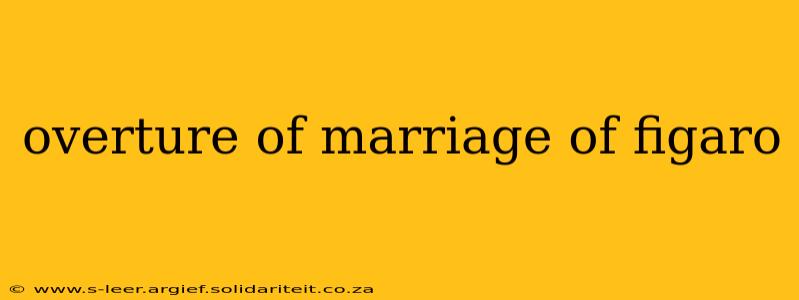The overture to Mozart's The Marriage of Figaro isn't just an introduction; it's a vibrant and captivating snapshot of the opera's comedic chaos and dramatic intensity. This instantly recognizable piece, full of energy and wit, perfectly sets the stage for the whirlwind of events to come. Its masterful construction and playful melodies have secured its place as one of the most beloved and frequently performed overtures in the classical repertoire. Let's delve deeper into its structure and significance.
What is the Overture's Structure?
The overture, like many classical overtures, follows a sonata form structure. This means it's organized into three main sections:
-
Exposition: This section introduces the main thematic material, usually two contrasting themes. In Figaro, the exposition begins with a dramatic, almost stormy introduction, hinting at the complexities and tensions within the opera's plot. This gives way to a more lyrical, graceful second theme, reflecting the lighter, more comedic aspects of the story.
-
Development: This is where Mozart takes the initial themes and playfully manipulates them. He fragments them, develops them in unexpected ways, and creates a sense of building excitement and suspense. This section is particularly brilliant in its use of counterpoint and orchestration, showcasing Mozart's mastery of musical texture.
-
Recapitulation: The recapitulation revisits the main themes from the exposition, but this time in the tonic key (the home key of the piece). This section provides a sense of resolution and closure, leaving the listener feeling prepared for the opera's unfolding narrative.
What Instruments Are Used in the Overture?
The orchestration of the Figaro overture is rich and varied, showcasing the full capabilities of the classical orchestra of Mozart's time. It prominently features:
- Strings: Violins, violas, cellos, and double basses provide the foundation of the orchestral texture, creating both delicate and powerful sounds.
- Woodwinds: Flutes, oboes, clarinets, and bassoons add color and melodic interest, enriching the overall texture.
- Horns: The horns contribute to the dramatic and powerful moments of the overture, adding a sense of grandeur and weight.
What is the Overture's Musical Character?
The overture's musical character is both dramatic and comedic. The opening storm clouds, giving way to sunshine, perfectly encapsulate the opera's blend of intrigue, deception, and ultimately, joyous resolution. The interplay between the major and minor keys adds to this duality, creating a constant sense of shifting moods and anticipation.
How Does the Overture Relate to the Opera?
The overture acts as a musical prologue, setting the tone and foreshadowing the thematic concerns of the opera itself. The contrasting themes reflect the contrasting personalities and relationships within the plot, foreshadowing the comedic and dramatic elements to come. The rapid changes in tempo and dynamic range mirror the rapid shifts in mood and emotion found throughout the opera.
What are Some Common Interpretations of the Overture?
The Figaro overture has inspired countless interpretations over the years. Some listeners focus on its comedic aspects, emphasizing the lightheartedness and playful nature of the music. Others highlight its dramatic elements, seeing it as a foreshadowing of the complex relationships and potential for conflict within the opera. Still others appreciate its sheer musical brilliance, highlighting Mozart's mastery of form, harmony, and orchestration.
Why is the Overture so Popular?
The popularity of the Figaro overture stems from several factors: its inherent musical beauty, its captivating structure, its evocative character, and its effective function as an introduction to a beloved opera. Its accessibility and enduring appeal make it a perennial favorite among classical music lovers and a testament to Mozart's enduring genius. The piece is often performed independently from the opera, showcasing its strength and beauty as a standalone work.
This exploration of the Figaro overture showcases its depth and complexity, making it clear why it remains a cornerstone of the classical music repertoire and a joy to experience for audiences worldwide.
